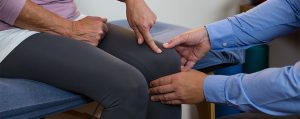Why Does My Achilles Tendon Hurt When I Run?
Our Achilles tendons don’t often get the praise they deserve. These large tendons on the back of our lower leg are surprisingly strong, and vitally important, especially for runners. The Achilles connects the muscles in our calves to our heel bones. Specifically, they connect the gastrocnemius and soleus muscles to the back of our calcaneus bone. Because of their attachment point, the Achilles tendons help propel us forward when we walk, run, or jump. Through this attachment, our Achilles tendons can withstand up to ten times our normal body weight when we run or jump. Just think about how many strides you took during your last run, and how many times up to ten times your body weight was placed on your Achilles tendon! Luckily you had a tough Achilles tendon to absorb all that force.
When to See an Expert for Ankle Pain
Ankle pain is a common reason many people see their physical therapist. It is often after a bad sprain or for a strained muscle. It can also occur following a more severe injury like a fracture or after surgery like an Achilles repair. These reasons for coming to physical therapy are fairly obvious. The injury typically happens suddenly, with a lot of swelling and pain.
Why You Shouldn’t Put Off Your Ankle Pain
We’ve all tweaked our ankles at some point in our lives. Some of us have even done it so forcefully that we have sprained a ligament, broken a bone, or strained a muscle. Hopefully, you took appropriate care and are feeling better, but often in my practice, I hear the dreaded phrase, “oh yeah, that’s my bad ankle. It never got better after I did (insert something youthful and nostalgic here).”
There are two forms of untreated ankle issues I see in the clinic regularly. The painful ankle that is effectively avoided or the stiff ankle that the patient thinks is normal. Both can have long-term effects on ankle health and wear and tear on the knees, hips, and even low backs.
Top Injuries in Male Gymnasts
Male and female gymnasts compete in similar but different events. Men’s gymnastics events place different demands on the body, especially the upper body, for events such as rings, high bar, parallel bars, and pommel horse. Therefore, the top injuries for male and female gymnasts may be different. Current research has shown that adolescent male gymnasts tend to have more lower-body injuries, whereas elite male gymnasts have more upper-body injuries. In general, male gymnasts tend to have more upper body injuries than female gymnasts.
4 Tips to Prevent Achilles Pain or Injury
Achilles pain or injury can prevent itself in the form of tendinopathy (i.e. tendinitis or tendinosis), or the more critical Achilles tendon tear or rupture. The Achilles tendon is the tendon to the gastroc and soleus, which together are known as the calf muscles. The role of a tendon is to transfer the force from the contracting muscle to the intended joint of movement. Together these muscles plantarflex the ankle joint, or point the foot downwards. This action creates the force needed to push the ground away and help propel the body forwards (or upwards) when we are walking, running, or jumping. The Achilles tendon is the strongest tendon in the body, and the gastroc and soleus are the primary ankle plantar flexor muscles.
Achilles Tendinopathy in Runners: Your Aching Heel Pain Can Be Helped
Does the aching pain in your heel have you adjusting your training program this running season?
Countless runners suffer from Achilles tendon injuries every year and these injuries can often be a limiting factor in your ability to maintain a training program, advance your mileage and meet your personal record goals. The good news is that we have therapists at Athletico trained and prepared to help you overcome this injury and get back to pounding the pavement.
